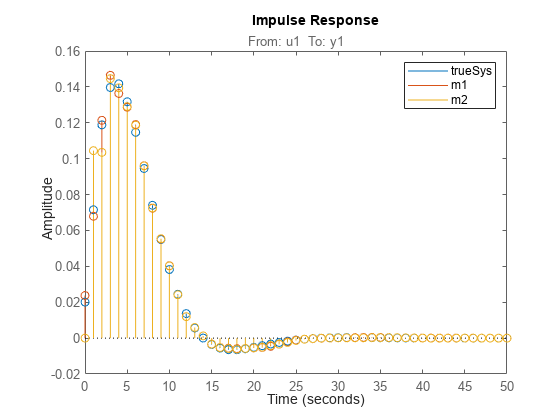ssregest
Estimate state-space model by reduction of regularized ARX model
Syntax
Description
Estimate State-Space Model
sys = ssregest(tt,nx)tt. You can use this syntax for SISO and MIMO systems.
The function assumes that the last variable in the timetable is the single
output signal. You can also use this syntax to estimate a time-series model if
tt contains a single variable that represents the sole
output.
For MIMO systems and for timetables that contain more variables than you plan
to use for estimation, you must also use name-value arguments to specify the
names of the input and output channels you want. For more information, see
tt.
To estimate a continuous-time model, set 'Ts' to
0 using name-value syntax.
sys = ssregest(u,y,nx,'Ts',Ts)u,y and the model sample time
Ts. The software assumes that the data sample time is
also Ts seconds. You can use this syntax for SISO, MISO,
and MIMO systems.
Estimating continuous-time models from matrix-based data is not recommended.
sys = ssregest(data,nx)data. Use this syntax especially when you want to
estimate a state-space model using frequency-domain or frequency-response data,
or when you want to take advantage of the additional information, such as data
sample time or experiment labeling, that data objects provide.
Specify Additional Options
sys = ssregest(___,nx,Name,Value)sys
=
ssregest(data,nx,'InputName',["u1","u2"],'OutputName',["y1","y3"]).
Use the 'Form', 'Feedthrough', and
'DisturbanceModel' name-value arguments to modify the
default behavior of the A, B,
C, D, and K
matrices.
Examples
Input Arguments
Name-Value Arguments
Output Arguments
More About
Tips
ssregestfunction provides improved accuracy thann4sidfor short, noisy data sets.For some problems, the quality of fit using
n4sidis sensitive to options, such asN4Horizon, whose values can be difficult to determine. In comparison, the quality of fit withssregestis less sensitive to its options, which makesssregestsimpler to use.
Algorithms
ssregest estimates a regularized ARX model
and converts the ARX model to a state-space model. The software then
uses balanced model reduction techniques to reduce the state-space
model to the specified order.
References
[1] Ljung, L. System Identification: Theory For the User, Second Edition, Appendix 4A, pp 132-134, Upper Saddle River, N.J: Prentice Hall, 1999.
